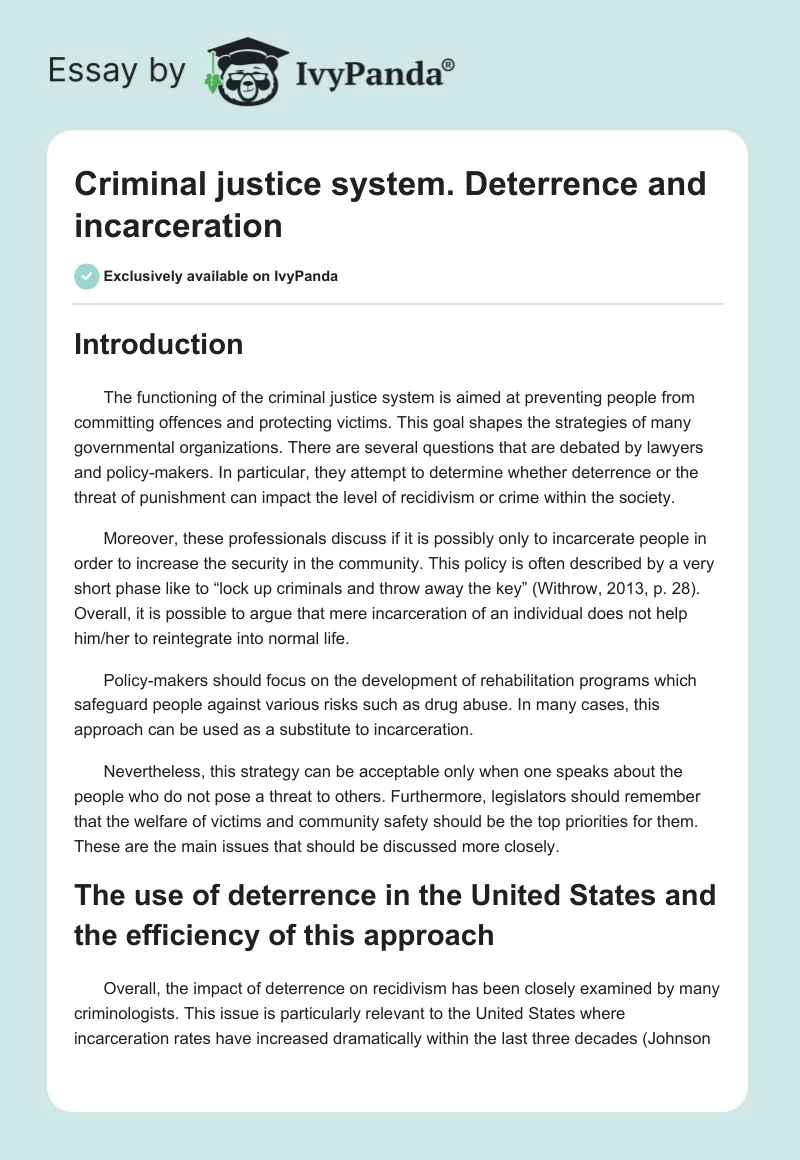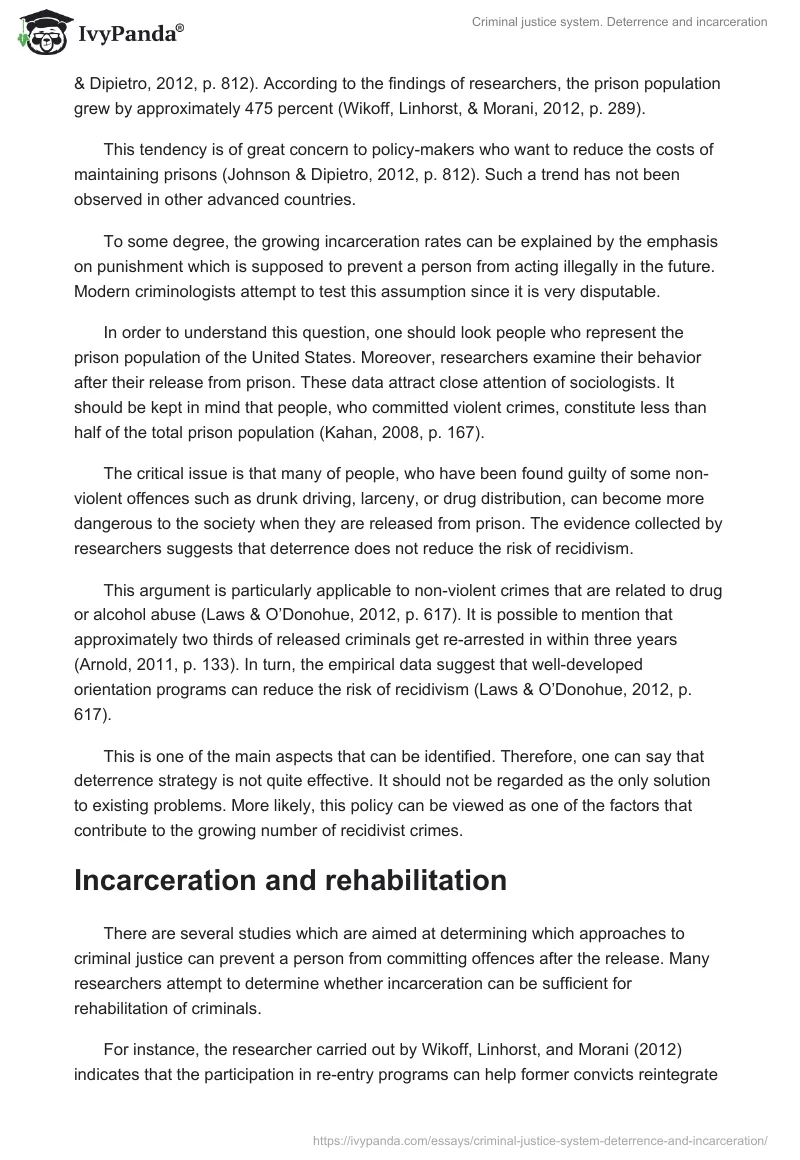Introduction
The functioning of the criminal justice system is aimed at preventing people from committing offences and protecting victims. This goal shapes the strategies of many governmental organizations. There are several questions that are debated by lawyers and policy-makers. In particular, they attempt to determine whether deterrence or the threat of punishment can impact the level of recidivism or crime within the society.
Moreover, these professionals discuss if it is possibly only to incarcerate people in order to increase the security in the community. This policy is often described by a very short phase like to “lock up criminals and throw away the key” (Withrow, 2013, p. 28). Overall, it is possible to argue that mere incarceration of an individual does not help him/her to reintegrate into normal life.
Policy-makers should focus on the development of rehabilitation programs which safeguard people against various risks such as drug abuse. In many cases, this approach can be used as a substitute to incarceration.
Nevertheless, this strategy can be acceptable only when one speaks about the people who do not pose a threat to others. Furthermore, legislators should remember that the welfare of victims and community safety should be the top priorities for them. These are the main issues that should be discussed more closely.
The use of deterrence in the United States and the efficiency of this approach
Overall, the impact of deterrence on recidivism has been closely examined by many criminologists. This issue is particularly relevant to the United States where incarceration rates have increased dramatically within the last three decades (Johnson & Dipietro, 2012, p. 812). According to the findings of researchers, the prison population grew by approximately 475 percent (Wikoff, Linhorst, & Morani, 2012, p. 289).
This tendency is of great concern to policy-makers who want to reduce the costs of maintaining prisons (Johnson & Dipietro, 2012, p. 812). Such a trend has not been observed in other advanced countries.
To some degree, the growing incarceration rates can be explained by the emphasis on punishment which is supposed to prevent a person from acting illegally in the future. Modern criminologists attempt to test this assumption since it is very disputable.
In order to understand this question, one should look people who represent the prison population of the United States. Moreover, researchers examine their behavior after their release from prison. These data attract close attention of sociologists. It should be kept in mind that people, who committed violent crimes, constitute less than half of the total prison population (Kahan, 2008, p. 167).
The critical issue is that many of people, who have been found guilty of some non-violent offences such as drunk driving, larceny, or drug distribution, can become more dangerous to the society when they are released from prison. The evidence collected by researchers suggests that deterrence does not reduce the risk of recidivism.
This argument is particularly applicable to non-violent crimes that are related to drug or alcohol abuse (Laws & O’Donohue, 2012, p. 617). It is possible to mention that approximately two thirds of released criminals get re-arrested in within three years (Arnold, 2011, p. 133). In turn, the empirical data suggest that well-developed orientation programs can reduce the risk of recidivism (Laws & O’Donohue, 2012, p. 617).
This is one of the main aspects that can be identified. Therefore, one can say that deterrence strategy is not quite effective. It should not be regarded as the only solution to existing problems. More likely, this policy can be viewed as one of the factors that contribute to the growing number of recidivist crimes.
Incarceration and rehabilitation
There are several studies which are aimed at determining which approaches to criminal justice can prevent a person from committing offences after the release. Many researchers attempt to determine whether incarceration can be sufficient for rehabilitation of criminals.
For instance, the researcher carried out by Wikoff, Linhorst, and Morani (2012) indicates that the participation in re-entry programs can help former convicts reintegrate into the community. Furthermore, the availability of educational or training programs is also critical essential for minimizing the possibility of subsequent offences (Wikoff et al., 2012). People, who can access such programs, are less likely to be convicted in the future.
These are some of the main aspects that should be identified. Moreover, the study by Hung-En Sung (2003) suggests that rehabilitation programs is essential for preventing prisoners from taking committing other offences that can be attributed to drug abuse.
Mere incarceration does not prompt people to reintegrate into the community. In most cases, it cannot improve the behavior of a person. More likely, this form of crime prevention can be substituted by compulsory rehabilitation programs. This is one of the approaches that can be taken.
These examples indicate the threat of punishment is not a sufficient for stopping crime or recidivism. These data should be considered by policy-makers and legislators since they are responsible for improving the criminal justice system. Moreover, mere incarceration is not effective for changing the behavior of a person who committed an offence.
Therefore, one cannot say that by merely imprisoning people, the state cannot make the society more secure. This is one of the main points that can be made. This issue is important because the growing prison population imposed a heavy burden on taxpayers. This is another aspect that should not be disregarded by people who work in the criminal justice system. They should not forget about the economic effects of their policies.
Violent crimes
Nevertheless, it is critical to remember that there are several important exceptions that should not be overlooked. In particular, there are people, who committed serious felonies, and they can pose a threat to the community. For instance, the recidivism rates among released child molesters are very high even though these people receive psychiatric assistance.
For instance, approximately, 5.3 percent of 9000 sex offended were subsequently re-arrested for the same crime (Levenson, Sandler, & Freeman, 2012, p. 555). Certainly, this percentage does not comprise the majority of all cases. Nevertheless, one should look at these qualitative data from the perspective of potential victims who should be safeguarded against possible risks.
Additionally, the actual number of crimes committed by these people can be much larger. The problem is that these rates are based on the data collected by law-enforcement agencies. Nevertheless, in many cases, the victims of this abuse do not report to the police.
This argument is relevant if one speaks about children who were victims of molestation (Waller. 2008, p. 264). This is one of the risks that should be overlooked by legislators and law-enforcement officers.
Discussion
This information is important for showing that very often, it is necessary to isolate some individuals from the society. Any other policy can be viewed as a form of irresponsibility and the government cannot accept it. Therefore, under such circumstances, incarceration can be the only solution available to policy-makers. There are many other cases like aggravated murder, human trafficking, and so forth.
Under such circumstance, legislators are obliged to protect former victims and other people. Therefore, one can say that sometimes deterrence and incarceration are important for preventing the crime.
This principle remains valid nowadays because police-officers or psychiatrists cannot accurately determine whether people convicted of serious felonies pose a threat to others. Certainly, these examples do not imply that every person, who has been convicted of a serious felony, should be sentenced to life imprisonment. It is not possible to make generalizations about such cases.
Conclusion
Overall, this discussion suggests that the functioning of criminal justice system cannot be reduced only to deterrence and incarceration. The main issue is that the state has to help a former offender integrate into the society. For instance, various rehabilitation programs, which are intended for offenders struggling with drug or alcohol abuse, can reduce the risk of later convictions.
The statistical evidence suggests that deterrence does affect the levels of crime or recidivism within a society. Nonetheless, there are circumstances when incarceration is the only option available to the state. Therefore, policy-makers should accurately identify the cases when incarceration can be substituted. This is the main principle that they should follow. In this way, they can make American society more secure.
Reference List
Arnold, D. (2011). Imind: The Art of Change and Self-therapy. New York, NY: AuthorHouse.
Hung-En Sung, H. K. (2003). Differential Impact of Deterrence as. Rehabilitation as Drug Interventions on Recidivism After 36 Months. Journal Of Offender Rehabilitation, 37(3/4), 95-108.
Johnson, B., & Dipietro, S. (2012). The power of diversion intermediate sanctions and sentencing disparity under presumptive guidelines. Criminology, 50(3), 811-850.
Kahan, D. (2008). “Punishment Incommensurability”. In B. Waller (Ed.), You decide!: current debates in criminal justice (pp. 167-175). New York, NY: Pearson Prentice Hall.
Laws, D., & O’Donohue, W. (2012). Sexual Deviance, Second Edition: Theory, Assessment, and Treatment. New York, NY: Guilford Press.
Levenson, J. S., Sandler, J. C., & Freeman, N. J. (2012). Failure-to-register laws and public safety: An examination of risk factors and sex offense recidivism. Law and Human Behavior, 36(6), 555-565.
Waller, B. (2008). Should There be Laws Requiring Registration and Community Notification for Convicted Sex Offenders. In B. Waller (Ed.), You decide!: current debates in criminal justice (pp. 253-267). New York, NY: Pearson Prentice Hall.
Wikoff, N., Linhorst, D. M., & Morani, N. (2012). Recidivism among participants of a reentry program for prisoners released without supervision. Social Work Research, 36(4), 289-299.
Withrow, B. (2013). Research Methods in Crime and Justice. New York, NY: Routledge.


